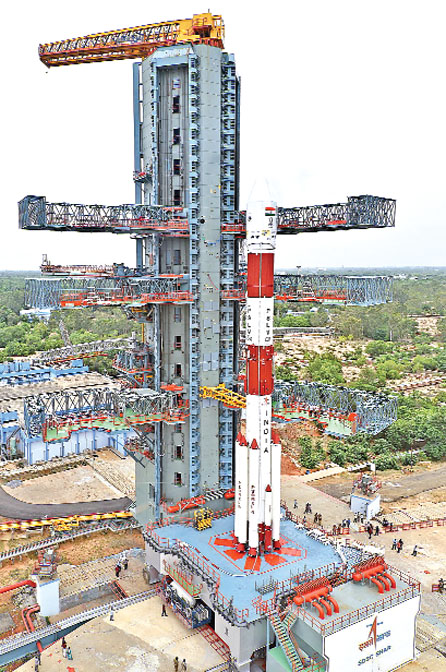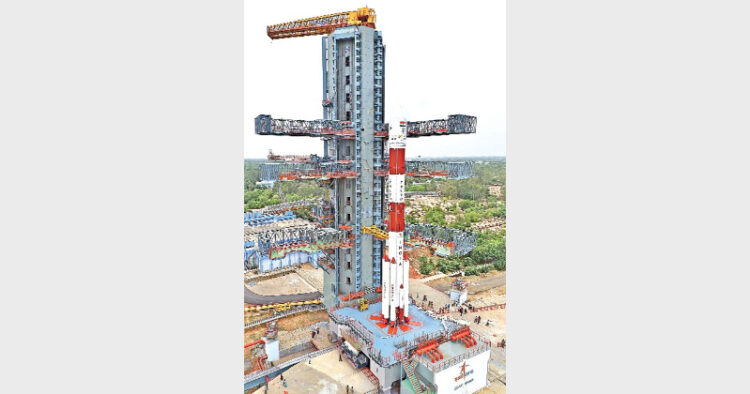 Scripting a new history by bettering and surpassing its earlier record, ISRO launched 20 satellites in a single PSLV mission on June 22
Scripting a new history by bettering and surpassing its earlier record, ISRO launched 20 satellites in a single PSLV mission on June 22
Radhakrishna Rao
Indian Space Research Organisation (ISRO) has once again made India proud. Indeed, the space spectacular pulled off by the Indian space agency with the precise launch of 20 satellites in a single PSLV (Polar Satellite Launch Vehicle) mission of June 22, 2016, has reaffirmed India’s status as a leading space faring nation that is second to none in the exploration of the final frontiers. In a major breakthrough for the Indian space programme, an augmented version of the trusted four stage, space workhorse PSLV accomplished the extraordinary feat of lobbing all the twenty satellites into orbit in one go in less than thirty minutes of its smooth take off from the second launch pad of Satish Dhawan Space Centre (SDSC), the Indian space port in Sriharikota island on India’s eastern coast. The total weight of all the twenty satellites placed into orbit was 1288 kg. The successful accomplishment of this multiple launch mission has given a big boost to India’s quest to emerge as a key player in the multi-billion dollar global market for launching satellites.
Key Achievements of ISRO
|
As many as seventeen satellites, belonging to international customers, were launched as piggyback payloads on-board PSLV on commercial terms. Among the foreign satellites ejected into orbit by this mission designated PSLV-C34—the 35th consecutively successful flight of PSLV powered by alternate liquid and solid fuel-driven stages—thirteen were from USA, two from Canada and one each from Indonesia and Germany. In addition, there were two Indian co-passengers onboard this PSLV mission. They were: Sathyabamasat weighing 1.5-kg from Sathyabama University and 1kg heavy Swayam from College of Engineering, Pune. Of course, the primary payload of this widely hailed space mission of awesome proportions was the ISRO built Cartosat-2 series advanced, new generation earth observation satellite whose potentials Indian defence forces can harness for surveillance and reconnaissance purposes. This satellite weighing 727.5 kg was placed into a polar/sun-synchronous orbit of 508-km. The data transmitted by Cartosat-2 series satellite will be useful in cartographic applications, coastal land use and regulation, creation of land use maps, precision study and various other applications. At the end of the day, Cartosat-2 series satellite will prove beneficial to both the defence forces and civilian sector.
The tech-savvy Indian Prime Minister Narendra Modi was quick to congratulate ISRO for the superb launch performance of PSLV. “Our space programme has time and again shown the transformative potential of science and technology in people’s lives,” said the Prime Minister. On his part, ISRO Chairman AS Kiran Kumar termed the mission as historic and drove home the point that many more such projects will follow reducing, the cost of access to space.
Certainly, ISRO has scripted history by bettering and surpassing its earlier record of launching ten satellites in one go by a PSLV mission of April 2008. According to ISRO, with the June 22 mission, the number of satellites launched by PSLV has touched 113 and of these 39 are Indian and 74 belong to the international customers of PSLV service. With a view to refine and augment the multiple satellite launch capability of PSLV, the fourth stage of the vehicle was subjected to an “experimental manoeuvre” on June 22. “This experiment was planned and executed to perfection. Now ISRO has the capability to launch satellites to multiple orbits, an ability that would attract several international customers,“ observed K Sivan, Director of the Thiruvananthapuram-based Vikram Sarabhai Space Centre(VSSC).
Bangalore-based Antrix Corporation, the commercial arm of the Indian space programme, which has been busy promoting PSLV as a cost effective and reliable space vehicle for launching small satellite payloads into near earth and mid earth orbits, is looking forward to attract more customers to the PSLV launch service. “We are finalising contracts with at least eight to ten customers. PSLV has now been rated the most reliable launch vehicle in the world. With the newly acquired capability of sending satellites to multiple orbits, we have a good case for attracting fresh businesses. In fact, small satellites market is booming and our Indian industry role here will be crucial,” observed S Rakesh Chairman and Managing Director of Antrix. Incidentally, Antrix generated a revenue of Rs.1800 crore last year and in the years ahead a rapidly expanding launch service will help Antrix boost its revenue by a substantial extent.
ISRO is now planning to rope in the Indian industries to take up the challenge of building satellites and launch vehicles and supply it in a ready to use condition. As things stand now, ISRO would need to launch a satellite every month. According to Kiran Kumar over the next five years, over 70 satellites would need to be placed into orbit. Right now there are 34 satellites in orbit providing services such as communications and broadcasting, earth observation, navigation as well as weather forecasting and disaster warning services.
The portfolio of India’s commercial launch service is set to expand with the introduction of three stage, high performance cryogenic fuel driven GSLV-MKII capable of carrying a payload weighing upto 2.5 tonne into a geostationary transfer orbit. The 400 plus tonne heavy GSLV-MKII, which has already logged two successful launches, would need to go through one or two additional flights as a prelude its deployment for commercial missions. ISRO has left none in doubt that once fully operational, the GSLV-MKII will be deployed for launching the satellites of international customers for a fee. Describing GSLV-MKII as a good
candidate for commercial payloads, Kiran Kumar has made it clear that “ISRO will have to repeat the launch success of GSLV-MKII to gain the
confidence of satellite owners.” The Indian commercial satellite launch business is expected to move into a higher orbit once the heavy lift GSLV-MKIII capable of placing a 4-tonne class satellite into a geostationary transfer orbit gets ready for routine orbital missions. Meanwhile, the GSLV-MK III with a takeoff weight of 630-tonne will have its full-fledged maiden orbital mission by 2106 end. As things stand now, not even the sky seems to be the limit for the Indian commercial launch service supported by the already proven PSLV and to be joined by GSLV-MKII and GSLV-MKIII. The formidable combination of these three launch vehicles has all the potentials to turn India into a major player in the global launch service market.
(The writer is a freelancer who writes on science, Tech and defence related issues)













Comments